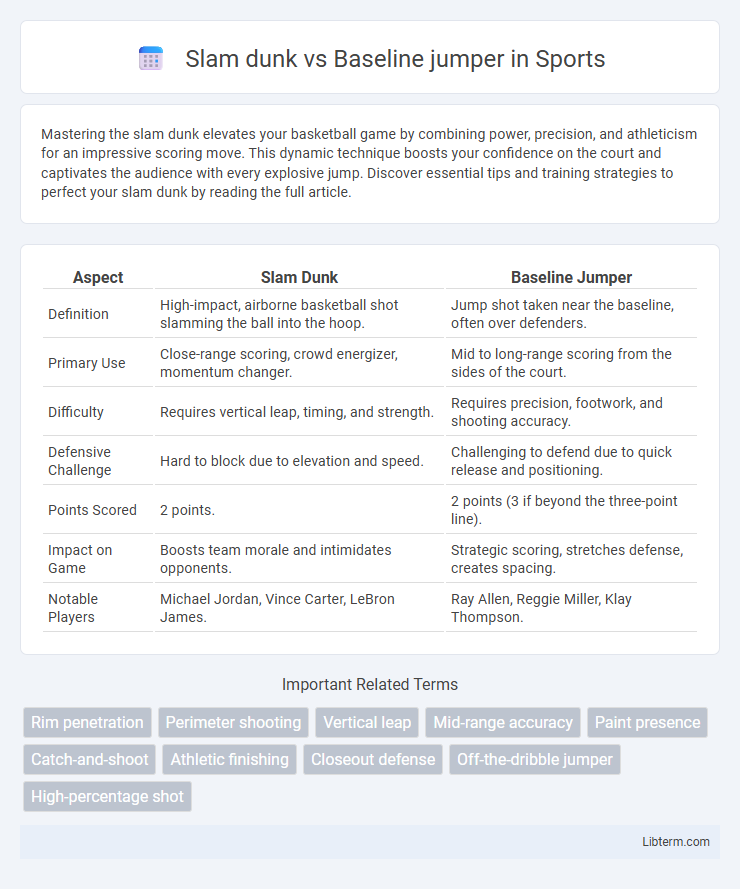Mastering the slam dunk elevates your basketball game by combining power, precision, and athleticism for an impressive scoring move. This dynamic technique boosts your confidence on the court and captivates the audience with every explosive jump. Discover essential tips and training strategies to perfect your slam dunk by reading the full article.
Table of Comparison
| Aspect | Slam Dunk | Baseline Jumper |
|---|---|---|
| Definition | High-impact, airborne basketball shot slamming the ball into the hoop. | Jump shot taken near the baseline, often over defenders. |
| Primary Use | Close-range scoring, crowd energizer, momentum changer. | Mid to long-range scoring from the sides of the court. |
| Difficulty | Requires vertical leap, timing, and strength. | Requires precision, footwork, and shooting accuracy. |
| Defensive Challenge | Hard to block due to elevation and speed. | Challenging to defend due to quick release and positioning. |
| Points Scored | 2 points. | 2 points (3 if beyond the three-point line). |
| Impact on Game | Boosts team morale and intimidates opponents. | Strategic scoring, stretches defense, creates spacing. |
| Notable Players | Michael Jordan, Vince Carter, LeBron James. | Ray Allen, Reggie Miller, Klay Thompson. |
Introduction: Understanding Slam Dunk and Baseline Jumper
A slam dunk is a high-impact basketball move where a player forcefully thrusts the ball through the hoop with one or both hands, showcasing athleticism and power. The baseline jumper, by contrast, is a precise mid-range or long-range shot taken near the baseline, requiring accuracy and technique rather than physical dominance. Understanding the fundamental differences between the explosive, crowd-pleasing slam dunk and the skillful, strategic baseline jumper highlights distinct offensive strategies in basketball gameplay.
Defining the Slam Dunk
A slam dunk involves forcefully thrusting the basketball down through the hoop with one or both hands, showcasing explosive athleticism and maximum vertical reach. This high-percentage shot is distinct from a baseline jumper, which is a jump shot taken near the baseline and requires precision and arc rather than raw power. The slam dunk's impact lies in its ability to energize the team and crowd, often serving as a highlight-reel play in basketball games.
Exploring the Baseline Jumper
The baseline jumper offers a strategic advantage by allowing players to shoot from the edge of the court with precision, often catching defenders off guard. Unlike the high-impact slam dunk, the baseline jumper requires refined shooting mechanics and spatial awareness to consistently score from a challenging angle. Mastering this shot enhances a player's scoring versatility and opens up offensive opportunities in tight defensive scenarios.
Key Skills Required for Each Move
Slam dunks demand explosive power, vertical leap, and precise timing to dominate the rim and finish strong against defenders. Baseline jumpers require exceptional footwork, body control, and accuracy from mid-range angles to create space and score efficiently along the edge of the court. Mastery of hand-eye coordination and situational awareness is essential for both moves to maximize scoring opportunities.
Physical Demands: Power vs Precision
Slam dunks require explosive power, vertical leap, and upper body strength to forcefully propel the ball through the rim, emphasizing raw athleticism and physical dominance. Baseline jumpers demand precise footwork, balance, and refined shooting mechanics to navigate tight angles and evade defenders, showcasing skillful control and accuracy. Both techniques engage different muscle groups and energy systems, with dunks taxing fast-twitch fibers and jumpers relying on fine motor skills and coordination.
Tactical Uses in Basketball Gameplay
The slam dunk serves as a high-impact scoring method, capitalizing on close-range positioning and crowd intimidation, often used to shift momentum during fast breaks or pick-and-roll situations. The baseline jumper provides tactical versatility by exploiting defensive gaps along the court's edge, enabling players to score from mid-range or create space for teammates through off-ball movement. Both techniques are essential for dynamic offensive strategies, blending power and precision to diversify scoring options and disrupt opponent defenses.
Slam Dunk: Impact on Team Momentum
Slam dunks significantly boost team momentum by energizing both players and fans, often leading to increased offensive pressure and improved defensive intensity. This high-impact play can shift the psychological dynamics of the game, forcing opponents to adjust their strategy under heightened pressure. Teams that consistently execute slam dunks tend to experience greater momentum swings, resulting in improved overall performance and higher scoring runs.
Baseline Jumper: Value in Scoring Efficiency
Baseline jumpers offer exceptional scoring efficiency by leveraging precise body control and quick release close to the basket, making them harder to block compared to slam dunks that require more space and timing. This shot benefits from high-percentage scoring opportunities in tight angles, creating valuable scoring chances alongside traditional inside plays. Teams focusing on baseline jumpers often achieve higher points per possession due to the combination of accuracy and the ability to score over defenders in congested areas near the basket.
Famous Players Known for Each Move
Michael Jordan and LeBron James are iconic for their powerful slam dunks that electrify crowds and dominate inside the paint. Ray Allen and Klay Thompson excel at the baseline jumper, showcasing precision and quick release from the court's edge. These signature moves define their playing styles and contribute significantly to their legacies in NBA history.
Conclusion: Choosing the Right Move for the Situation
Selecting between a slam dunk and a baseline jumper depends on factors such as player positioning, defensive pressure, and scoring opportunities. Slam dunks offer high-percentage, crowd-energizing scores ideal in close-range, fast-break scenarios, while baseline jumpers provide precision and spacing advantage in tight defensive setups. Mastering both moves enhances versatility, allowing adaptive decision-making based on game context and team strategy.
Slam dunk Infographic

 libterm.com
libterm.com